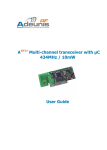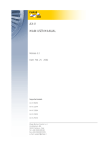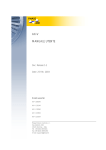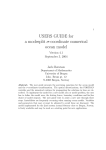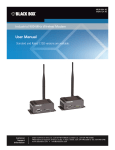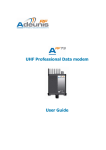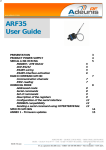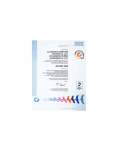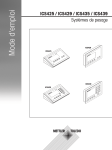Download A UART TTL modules User Guide
Transcript
ARF54 UART TTL modules User Guide No part of this document may be reproduced or transmitted (in electronic or paper version, photocopy) without Adeunis RF consent. This document is subject to change without notice. All trademarks mentioned in this guide are the property of their respective owner. ADEUNI S RF 283, rue Louis Néel 38920 Crolles France Phone Fax +33 (0)4 76 92 07 77 +33 (0)4 76 08 97 46 Ref. 07-12-V5-ptr ARF54 User Guide Table of Contents About this Document........................................................................................2 Declaration of Conformity ...............................................................................3 Download of the user guide ................................................................................. 3 Overview ..........................................................................................................4 I nterface ..........................................................................................................4 Mechanical specification....................................................................................... 4 Signal description ................................................................................................ 6 General purpose I/O extended functionality .......................................................... 7 Radio communication.....................................................................................10 Radio communication .........................................................................................10 Radio channels...................................................................................................11 Channel adjustment ...........................................................................................11 Radio rate selection............................................................................................11 Channel rejection ..............................................................................................12 Transceiver operating mode...........................................................................12 Command mode.................................................................................................13 Transceiver mode...............................................................................................14 Transparent mode..............................................................................................15 Addressed mode ................................................................................................15 Transceiver state machine ..................................................................................15 AT COMMANDS...............................................................................................16 Description ........................................................................................................16 Set of commands ...............................................................................................17 Register description............................................................................................18 Power management (standby mode and low power mode) ...................................22 Disable Low Power down mode :............................................................................23 Specifications.................................................................................................24 Glossary .........................................................................................................25 ANNEX 1 : Alternative mounting ....................................................................26 ANNEX 2 : Firmw are updates .........................................................................26 Ref. 07-12-V5-ptr p. 1 ARF54 User Guide About this Document This guide describes the ARF54 devices, their options and accessories. Ref. 07-12-V5-ptr p. 2 TOP ARF54 User Guide Declaration of Conformity Manufacturer’s name: Manufacturer’s address ADEUNI S R.F. Parc Technologique PRE ROUX IV 283 rue Louis NEEL 38920 CROLLES - FRANCE declares that the product if used and installed according to the user guide available on our web site www.adeunis-rf.com Product Name: Product Number(s): is designed to comply EMC: Safety: Radio: ARF54 ARF7429A with the RTTE Directive 99/5/EC: according to the harmonized standard EN 301 489. according to the standard EN 60950-1/2001 according to harmonized standard EN 300-220 covering essential radio requirements of the RTTE directive. Notes: - Conformity has been evaluated according to the procedure described in Annex III of the RTTE directive. - Receiver class (if applicable): 3. According to the 1999/519/EC recommendation, minimum distance between the product and the body could be required depending on the module integration. Warnings: - CE marking applies only to End Products: Because this equipment is only a subassembly, conformity testing has been reduced (equipment has been design in accordance to standards but full testing is impossible). Manufacturer of End Products, based on such a solution, has to insure full conformity to be able to CE label marking. - As the integration of a radio module requires wireless technological knowledge, ADEUNIS RF proposes its technical proficiency to its customers for a precompliance qualification of end products. In case of no-conformity, ADEUNIS RF will not be held back responsible if this stage has not been realised. Crolles, November 6th, 2007 VINCENT Hervé / Quality manager Dow nload of the user guide Thank you for having chosen the ADEUNIS RF products. NOTA : this product is set up in Narrow Band (channel 19) to optimize the range. The radio data rate is then limited to 10 kBps. To modify these parameters thank you to apply the instructions mentioned on the user guide downloadable on our web site www.adeunis-rf.com Index Products Paragraph OEM Modules > UART TTL Transceivers Print version available upon request 9 Tel : +33 4 76 92 07 77 9 Email : [email protected] Ref. 07-12-V5-ptr p. 3 TOP ARF54 User Guide Overview The ARF54 radio transceiver converts data from a serial link into a radio frame to be sent to a similar piece of equipment. The communication is halfduplex. The operating parameters of these radio transceivers (serial link, radio management…) can be fully updated through AT commands via the serial link. I nterface Mechanical specification The transceiver is available in only one format: plugged module without antenna. Ref. 07-12-V5-ptr p. 4 TOP ARF54 User Guide The PCB width is 12/10 mm Figure 1: Plugged module mechanical feature This module has been designed to be plugged (as describe above). If this assembly doesn’t suit your requirement, please have a look to Annex 3 (mainly for horizontal mounting). Ref. 07-12-V5-ptr p. 5 TOP ARF54 User Guide Signal description I nterface Pin Name I/ O 1 2 8 7 GND VDD TXD RXD 3 /RTS 10 5 /RESET PWD GPIO1 / PC0 GPIO2 / PC1 GPIO3 / PC2 GPIO4 / PC3 GPIO5 / PC4 GPIO6 / PC5 GPIO7 / PD5 GPIO8 / ADC7 GND Description Alternate function Digital interface 16 13 14 11 12 9 6 15 17, 18 I I I/O Ground Operating voltage Serial data transmission Serial data reception Request To Send RTS = GND, the transceiver is able to receive serial data RTS = VDD, serial data received by the transceiver are lost Transceiver Hardware RESET, active LOW. Power down management Extended general purpose I/O I/O Extended general purpose I/O I/O Extended general purpose I/O I/O Extended general purpose I/O RS485 I/O Extended general purpose I/O RS485 I/O I/O Extended general purpose I/O or I (input only for the American version) Extended general purpose I/O RS485 ADC Analog to digital conversion O I O RS485 Ground RF interface 19, 20 21, 22 23, 24 GND RF RF in/out GND RF Ref. 07-12-V5-ptr RF antenna ground RF antenna IN/OUT. RF antenna ground. p. 6 TOP ARF54 User Guide Vil1 Vih1 Vil2 Vih2 Description Input low voltage except /RESET Input High voltage except /RESET /RESET Input low voltage /RESET Input High voltage /RESET pulse width Min -0.5 Max 0.3VDD Unit V 0.6VDD VDD+0.5 V -0.5 0.9VDD 2.5 0.2VDD VDD+0.5 - V V µs General purpose I / O extended functionality RS485 interface The S215 register allows enabling the management of the control lines (/RE and DE lines) of most RS485 buffer. The following figures illustrate the RS485 wiring and the configuration required for activating the DE and /RE management. Even one line is sufficient, for more flexibility two different lines could managed the DE and RE RS485 control lines. Hereafter a connection example with both lines or one line only. Ref. 07-12-V5-ptr p. 7 TOP ARF54 User Guide CAUTI ON • • 215 Value the /ENABLE485 is read ONLY at power-up. Changing the /ENABLE485 (GPIO7) when the transceiver is already running will not be taken in account. when activating the RS485 interface the GPIO5 will be set as an output. DE/ RE state 1 / ENABLE 485 ( GPI O7) GND 1 0 VDD Input Input Input Output Note RS485 control lines management RS232 configuration RS232 configuration GPI O2 GPI O4 GPI O5 GPI O7 Outp ut Input Input Outp ut Input Input Outp Input ut Input Input Input Input Table 1: R485/ 232 configuration settings Ref. 07-12-V5-ptr p. 8 TOP ARF54 User Guide By default, the DE and RE lines are asserted LOW, allowing the reception of characters from the RS485 differential bus. The DE and RE lines are asserted HIGH only when one or several characters have to be transmitted over the RS485 differential bus: when a radio frame is demodulated, the lines are asserted HIGH and then the data extracted from the radio frame are sent to the module TXD line and therefore to the RS485 differential bus. When the last character has been transmitted over the RS485 differential bus, the lines are asserted LOW. • TXD n DATA bytes Td e Th old DE/RE Figure 2: DE/ RE timing when data are sent over the serial link • • S219 Tde min 0 15 µs • RXD Thold : minimum = 1 µs Tde : set according to the S219 register value (see table hereafter) 1 35 µs 2 65 µs 3 135 µs 4 150 µs 5 190 µs 10 330 µs 20 600 µs 40 1.1 ms 60 1.7 ms 80 2.3 ms In command mode, when a reply is sent back (on the TXD line) according to the following DE/RE timing : CMD TXD Ref. 07-12-V5-ptr REPLY p. 9 TOP ARF54 User Guide ≥700 µs ≥ 100µs ≥ 100µs DE/RE Radio communication Radio communication 869 MHz version This modem has several channels over the 863-870 MHz Band that can be selected using AT commands, distributed in Wide Band and Narrow Band. Wide Band channel : • 1 Wide Band channels • 57.6 kbit/s “air rate” • channel spacing: 500 kHz • Sensitivity: - 105 dBm • Adjacent channel rejection: see chapter Channel rejection Narrow Band channel : • 3 Narrow Band channels • 10 kbit/s “air rate” • channel spacing: 100 kHz • Sensitivity: - 110 dBm • Adjacent channel rejection: see chapter Channel rejection • This module is designed to operate according to CEPT/ERC/REC 70-03 recommendation. This recommendation has been drawn up by the European Radio communications Committee (ERC) under CEPT. Ref. 07-12-V5-ptr p. 10 TOP ARF54 User Guide Radio channels 869 MHz version The Wide Band channel are selected according to the following table: Channel S200 1 Frequency ( MHz) 869,525 Figure 3: Wide band channels The 3 Narrow Band channels are selected according to the following table : Channel S200 19 84 85 Frequency ( MHz) 869,450 869,525 869,600 Figure 4: Narrow Band channels Channel adjustment The S200 register allows choosing the desired channel and the associated radio rate (see Erreur ! Source du renvoi introuvable.). Radio rate selection For 869 MHz version, the Radio rate selection is automatically done when setting the channel number: If you choose a channel number ≥ 14 (Narrow Band), the radio rate will automatically switch to 10 kbit/s. Ref. 07-12-V5-ptr p. 11 TOP ARF54 User Guide If you choose a channel number < 14, the module will operate in the Wide Band configuration. The radio rate will switch automatically to 57600 bit/s. Channel rejection The graph below shows the typical channels rejection in WideBand (WB) and NarrowBand (NB) modes. 80 70 rejection (dB) 60 50 40 WB 30 NB 20 10 -2000 -1750 -1500 -1250 -1000 -750 -500 -250 0 250 500 750 1000 1250 1500 1750 2000 frequency step / Fchannel (kHz) Particular attention is required for product installation. In the case where several links must works in the same area (independently of the channel positions), the minimum distance between 2 products belonging to different radio links is 3 meters. Even with this precaution (depending of the product environment), channel rejection could be reduced. Transceiver operating mode Two operating modes are available : 1. Command mode (usage of AT commands) 2. Transceiver or normal mode (serial data are transmitted on radio link) Ref. 07-12-V5-ptr p. 12 TOP ARF54 User Guide At power up the transceiver is in transceiver mode: it is able to send / receive data to / from the radio link according to its current parameter configuration. Command mode The command mode is used to read and update the modem configuration registers using AT command. In command mode, the radio is inhibited (reception and transmission), excepted when using test command. Entering command mode : issues on the serial link a +++ sequence. The sequence of 3 consecutive + characters is accepted only if no character have been seen before and after the +++ sequence. Register (S214) defines the silence duration. Tips 1: if you are using a terminal (such as Hyperterm), you have to send the +++ sequence using a text file (first create a text file containing only the +++ characters, and then use in Hyperterm the command “Send text file” in the “Transfer menu”) Tips 2: Idle line for S214 duration RXD line +++ (consecutive) + + Idle line for S214 duration + TRANSCEIVER MODE COMMAND MODE Exiting command mode (return back in transceiver mode): send the serial command ATO <cr> Ref. 07-12-V5-ptr p. 13 TOP ARF54 User Guide Transceiver mode In transceiver mode, two protocols are available: 1. Transparent mode, without flow control. 2. Addressed mode, with flow control (see register S216) The communication is always half-duplex. The radio transmission is processed prior to the radio reception (when the transceiver is sending a radio frame, it is not able to decode any incoming radio frame). If no data are sent on the serial link, the modem is waiting for radio reception. Each radio frame sent by another modem is received and the validated data extracted from the radio frame are sent on the serial link. When the last character has been sent on the serial link, it is possible to send an answer at least 100 µs (minimum) after the end of this last character. TXD (from RF link) CMD RXD REPLY Minimu m ≥ 100µs All the data received on the serial link are encapsulated in a radio frame. The radio frame format depends on the used protocol. When acting as transceiver, the radio frame transmission always starts under the following conditions : Detection of a silence on the serial link (greater than S217) after the reception of the latest character. Or when the number of received characters from the serial link is higher or equal to the maximum radio frame size (S218). Ref. 07-12-V5-ptr p. 14 TOP ARF54 User Guide Transparent mode In transparent mode, the modem acts as a wire serial link. It means that alternately, the modem sends on the radio the data received from the serial link and sends on the serial link the data received from the radio. The radio frame format is : • <Preamble><synchro>DATA <postambule>. Preamble, synchronisation and postambule are used for the radio reception. Addressed mode In transmission mode, data received on the serial link are sent on the radio link with the following format : • <Preamble><synchro><Address> DATA <postambule>. Preamble, synchronisation and postambule are used for the radio reception. • The Address field is set up with S256 value (LSB first). • In reception mode: The <Address> field of the radio frame is checked with the reception address (S252) • If the radio frame address matches the transceiver reception address (S252), DATA (and only DATA) are transmitted on the serial link Otherw ise received data are silently discarded. Transceiver state machine When operating in transceiver mode the 'RF transmission' state machine is : Idle state of the transceiver : by default the transceiver is waiting for incoming data on the RS232 link and for incoming radio frame on the radio link. Ref. 07-12-V5-ptr p. 15 TOP ARF54 User Guide The RS232 link has a higher priority than the radio link (if a radio frame is demodulated meanwhile some RS232 characters are detected on the serial link, the radio frame will be discarded and the RS232 incoming data will be processed). Processing incoming RS232 data : the incoming RS232 data are internally buffered. The buffered data are sent in a radio frame (the RF modulation is started) when almost one of the following conditions occurs: if a break (silence greater than S217 timeout) is detected on the incoming serial flow (no more data to be sent). if the radio buffer size is reached (the number of buffered characters are equal or greater than the S218 size). Processing incoming radio frame : the valid data are extracted from the incoming radio frame and internally buffered. The buffered data are sent on the fly to the RS232 module output. AT COMMANDS Description AT commands are interpreted only w hen the transceiver is in Command mode. Command : are used to read and update the modem parameters • A command starts with the 2 ASCII ‘AT’ characters. ‘AT’ means ‘Attention’ follow with one or several characters or other data. • Each command is ended with <cr> (carriage return). • In the same command, the time between 2 characters must be less than 10s. Response: is sent back for each command on the serial link. The answer is: • ‘O’<cr> (ASCII character 0x4F) for accepted command (or OK command) • ‘E’<cr> for error • Specific string when specified Ref. 07-12-V5-ptr p. 16 TOP ARF54 User Guide Set of commands Commands ATO <silence>+++<silence> ATSn? ATSn=m AT&W AT/S AT/V ATR ATT1 ATT2 ATT3-ATT6 Description Operating mode selection Return back to transceiver mode. Command mode activation. The +++ sequence must be preceded and followed by a calibrated silence (no other character) Registers management Displays the Sn register content where n represents the register number. The response has the following format: Sn=y<cr><lf> Sets the Sn register value with ‘m’. n represents the register number.. Saves the new register configuration in EEPROM. Each time you switch on the modem, the EEPROM configuration will be loaded in the modem registers. Displays all register values. The response has the following format: Sxxx=y<cr><lf> for each register. Software version display. The response has the following format: Adeunis RF Versatile Modem II 868 MHz 500mW Vxx.yy<cr><lf> Restore the register default values Test modes Pure Carrier (data=0) transmission using current channel. The output of this mode is achieved by reception of any character on the serial link. Pure Carrier (data=1) transmission using current channel. The output of this mode is achieved by reception of any character on the serial link. Modulation using current channel. The output of this mode is achieved by reception of any character on the serial link. ATT3: 0.9 KHz modulation ATT4: 3.6 KHz modulation ATT5: 14.4 KHz modulation ATT6: 28.8 KHz modulation AT/S is not available for baud rate lower than 2400 bauds Ref. 07-12-V5-ptr p. 17 TOP ARF54 User Guide Register description The register value could be updated using the ATSn=m<cr> command and displayed using ATSn?<cr> command. At power-up, the previous transceiver configuration is restored from E2PROM (non volatile) to RAM. The registers are located in RAM registers, any modification is performed on RAM registers: To save current register configurations, it is necessary to use the AT&W<cr> command (If not, the updated parameters are lost in case of power shortage). The registers are shared in 2 types: read only (R) or read/write (R/W) Type R/W Register Function S200 Description Radio management Channel number Radio channel for 896 MHz version : 1, Wide Band channel. 19, 84 ou 85, Narrow Band channels. Default value Note 1 3 When leaving factory, this product is set up in Narrow Band (channel 19) to optimize the range R/W S202 Command mode, Automatic command mode exit auto-exit 0 : (no specific management), the command mode will be exited only when an ATO command is issued. 0 From 1 to 60 : timeout in second. Î If no activity (no character, command reception) is detected in command mode for the programmed timeout, the command mode will be exited. The module is back to transceiver mode R/W S204 Preamble duration R/W S217 Serial timeout for Serial timeout before starting radio radio transmission, unit ms. From 3 up to 240. Ref. 07-12-V5-ptr Preamble duration, unit ms From 4 up to 50 5 4 3 1 p. 18 TOP ARF54 User Guide Type Register Function R/W S218 Radio frame length R S230 RSSI level Description Default value Size of the radio frame (from 1 up to 240). 128 When this size is reached: 1. the transceiver sends a radio frame 2. The RTS signal is activated (pull to VDD) only if the module is operating in the addressed mode. Displays the reception level of the latest received message. Response: S230=-xxx dBm<cr><lf> with xxx decimal value Note None Example S230=-80 dBm R/W S231 RF OUT level Adjusts the RF out level 3 0 => 20 dBm (100 mW) 1 => 23 dBm (200 mW) 2 => 24,5 dBm (<450 mA for USB power supply) 3 => 27 dBm (500 mW) R/W S210 Baudrate R/W S211 Data length R/W S212 Parity Ref. 07-12-V5-ptr Serial link Serial link rate in bits/s ‘0’: 600 ‘1’: 1 200 ‘2’: 2 400 ‘3’: 4 800 ‘4’: 9 600 ‘5’: 19 200 ‘6’: 38 400 ‘7’: 57 600 4 1,2, 5 ‘7’ : 7 bits ‘8’ : 8 bits 8 5 ‘1’ : none ‘2’ : even ‘3’ : odd 1 5 p. 19 TOP ARF54 User Guide Type Register Function Description Default value 1 Note 1 R/W S213 Stop bits ‘1 ‘ : 1 stop bit ‘2’ : 2 stop bit R/W S214 Command timeout Time out duration for detecting the +++ pattern, unit ms. From 3 up to 240. 3 R/W S215 Interface type ‘0’ : RS232 only ‘1’ : RS232 or RS485 (managed DE/RE lines) 1 R/W S216 Handshake ‘0’ : hardware, RTS (restricted to addressed protocol) ‘2’ : none 2 R/W S219 RS485 delay 3 R/W S220 Protocol Delay between DE activation and the first RS485 transmitted byte From 0 up to 160 Protocol ‘1’= transparent mode ‘6’= addressed R/W S252 Reception address From 0 up to FFFF Used in addressed protocol only, for filtering incoming frame R/W S256 Transmission address From 0 up to FFFF Used in addressed protocol only, added to out coming frame R/W S232 Power management Miscellaneous 0 disable modes 1 immediately enter standby mode 2 enable low power down mode 5 6 0 N OTE 1 when a serial speed change is requested, the S214 and S217 registers values are automatically set to a value greater or equal than the duration of three characters in the requested speed (13 ms for 2400 bauds, 7 ms for 4800, 3 ms otherwise). Ref. 07-12-V5-ptr p. 20 TOP ARF54 User Guide N OTE 2 streaming mode without flow control. Be careful Î using a serial rate greater to the radio rate must produce character losts if the flow control is not used. If the radio rate is equal to the serial rate, the radio frame is longer than the serial frame, due to radio protocol overhead; but the radio overhead will be generated only when the radio transmission begins Î this overhead will be absorbed by internal buffer size. For example, if the current radio rate is 10 kbit/s, a serial rate of 9 600 should be used without flow control, while using a serial rate of 19 200 (with 10 kbit/s for the radio rate) will produce data overrun. For avoiding character lost, you should : 1. use the flow control (addressed mode with hardware handshake) 2. or use a serial rate lower or equal to the radio rate 3. or limit the size of serial data to the maximum size of the internal buffer (S218). N OTE 3 (S200 register) see chapt. Erreur ! Source du renvoi introuvable. and chapt. Erreur ! Source du renvoi introuvable. N OTE 4 The preamble duration is linked to the current radio rate. The preamble values are : WB channel (high radio rate) NB channel (low radio rate) Default prea mble value Minim um prea mble value 5 ms 4 ms 20 ms 10 ms BE CAREFUL Keep in mind reducing preamble duration below default value will reduce transmission delay but generate possible frame error rate (up to 1 or 2/1000)!!! Ref. 07-12-V5-ptr p. 21 TOP ARF54 User Guide N OTE 5 when changing the serial link configuration (rate, parity, stop bit…), the answer is done using the old serial link format, the next command must be sent using the new serial format. N OTE 6 the S232 management is described in the following paragraph. Pow er m anagement ( standby mode and low pow er mode) Two modes are available for power management : A standby mode, with a short wake-up time. A low power consumption mode with a longer wake-up time (including supply stabilisation and radio calibration) 1. 2. Standby mode Entered Low pow er consumption mode When : in command mode When : in transceiver mode How : set S232 register to 1, issuing the AT command How : a high level (or pin left unconnected) on the PWD signal puts the module in low power mode ATS232=1<cr> Condition: the low power mode consumption must be enabled (see hereafter) Exited How : when receiving the following string ATS232=0 State after w ake up : transceiver mode How : a low level on PWD signal wakes up the device State after w ake up : transceiver mode Consumpt ion ≤ 4 mA (2.5 mA typical, to be refined) ≤ 30 µA (To be refined) Wake-up time < 100 µs 5 ms Ref. 07-12-V5-ptr p. 22 TOP ARF54 User Guide Enable Low Pow er dow n mode : The low power down mode is managed only after its activation. Applying a High level on the PWD signal when the mode has not been activated has no effect Î the module is still running in its current mode. In command mode, send the AT command ATS232=2<cr>. After this, a High level applied on PWD signal during transceiver mode allows the module to enter the low power consumption mode. Disable Low Pow er dow n mode : In command mode, enter the AT command ATS232=0<cr> the S232 register is not applicable Ref. 07-12-V5-ptr p. 23 TOP ARF54 User Guide Specifications 868 / 870 MHz European version Embedded protocol ADEUNIS RF enhanced & versatile RF comms manager Embedded profiles High Data rate Monochannel modem Middle Data Rate Monochannel modem Link set-up and status Through Hayes commands Radio rough data rate 10 000 & 57 600 bps UART programmable format Serial rate from 600 bps to 57,6 kbps UART TTL ports TXD – RXD – RTS – CTS or RS485 driving capability Transceiver multi-modes Transparent or Addressed Programmable Frequency 869.4 to 869.65 MHz / Europa Channelization Adjusted to improve sensitivity and narrow band) Programmable Radiated RF power Up to 500 mW (27 dBm) Sensitivity Down to –110 dBm (for 10-3/PN9) Operating range (open space) External antenna : up to 3000 m RSSI level RF signal qualification Operating voltage Regulated 3.3V nominal (2.7 to 3.6 V) TX / RX consumption (max) 700 mA / 35 mA Ref. 07-12-V5-ptr (wide p. 24 TOP ARF54 User Guide Power Down current < 30 µA (to be defined) Operating temperature -30°C / +70°C Dimensions 42 x 20 x 4 mm Standards compliance EN 300-220 / EN 301 489 References ARF7429A : Plugged module w ithout antenna Glossary TBD To Be Defined NC Not Connected NU Not Used FHSS Frequency Hopping Spread Spectrum FIFO First In First Out WB Wide Band NB Narrow Band Ref. 07-12-V5-ptr p. 25 TOP ARF54 User Guide ANNEX 1 : Alternative mounting If the module cannot be plugged directly on the motherboard, it is possible to mount a connector. However, we do not recommend this use to keep the radio stability of the module. Some references of connector Module header : • Vertical Male header: Antelec ref. AM2D 200 26 6 G Motherboard receptacle : • Vertical Female receptacle (Through Hole) : Antelec ref. AF2D 200 26 G • Right Angle Female receptacle (Through Hole) : Antelec ref. AF2C 200 26 49 G • Vertical Female receptacle (Surface Mount) : Antelec ref. AF2D 200 26 G CMS • Right Angle Female receptacle (Surface Mount) : Antelec ref. F2C 200 026 G CMS ANNEX 2 : Firmw are updates Firmw are Updates Document V4 Updates NB configuration when leaving factory, electrical specification VIx/VOx Ref. 07-12-V5-ptr p. 26 TOP




























